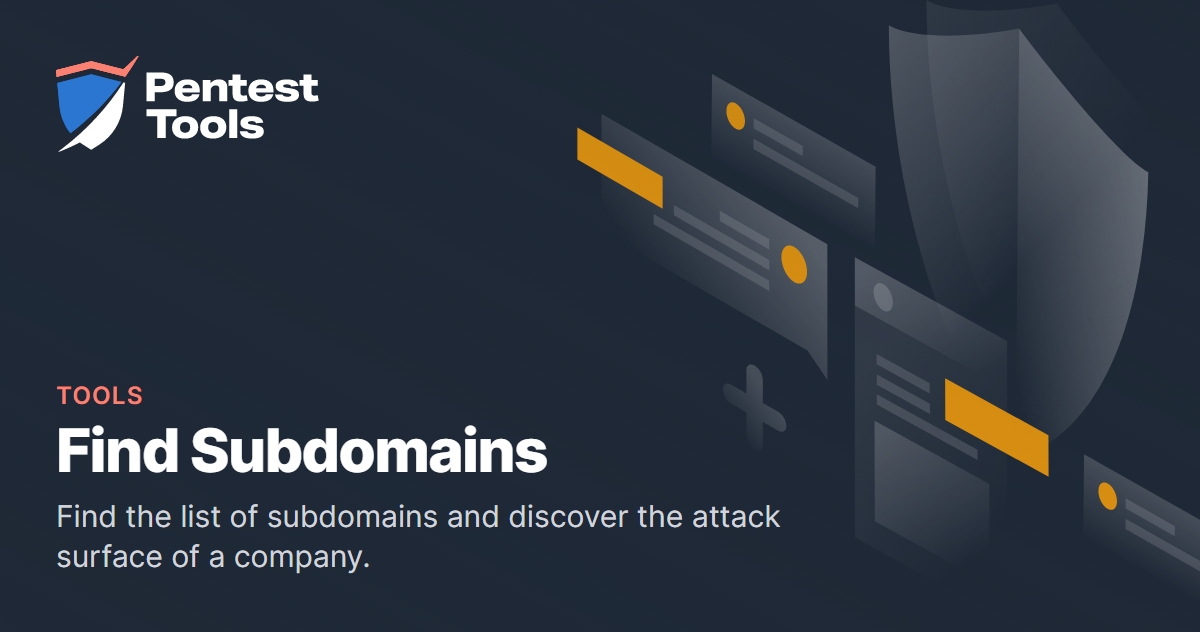FAQs
The Deep scan uses multiple techniques to find subdomains fast and effectively:
- DNS records (NS, MX, TXT, AXFR)
- Enumeration using built-in wordlists, plus the option to use your own.
- External APIs search.
- Public search engine queries (Google search, Bing)
- Word mutation techniques.
- Searching in SSL certificates.
Here are ten highly effective options.
- Google Dorking. Google Dorking is a passive subdomain enumeration technique using Google's advanced search operators, like "site:" to find information about a target, including subdomains. ...
- Sublist3r. ...
- Amass. ...
- Recon-ng. ...
- SubDomainizer. ...
- Pentest Tools Subdomain Finder. ...
- crt.sh. ...
- Shodan.
Subdomains aren't directly bad for SEO, but they're not always the most strategic choice.
How to get a website subdomain? ›
To create a subdomain, please do the following:
- Go to your Domain List and click Manage next to the domain:
- Select the Advanced DNS tab:
- Find the Host Records section and click on the Add New Record button (not able to edit Host Records?):
- Select the way your subdomain will be connected from the list below:
Google bots can find and index pages on a subdomain in the same way they do on a subdirectory. Subdomains also have several advantages in terms of what Google looks for in an authoritative website.
Does Google show subdomains? ›
The short answer is yes, Google can and will index and rank subdomains unless you explicitly take steps to ensure they're excluded from its index. Google's entire business model is based on discovering content. The same goes for all search engines.
What is a subdomain finder? ›
Subdomain Finder scans the DNS records and supplementary databases to analyze the domain's hierarchy. Our subdomain scanner checks: DNS records (NS, MX, TXT, AXFR) DNS enumeration. SSL certificates.
Are subdomains still used? ›
People use subdomains for things like blogs, country-specific locations, or any time it feels like there are substantial resources on a topic, and they don't want to build out the main site. One example would be a help center like support.google.com. In all cases, subdomains help to organize the content by theme.
Does Google index subdomains? ›
And make sure you don't have a bit like "meta name="robots" content="noindex, nofollow"" else Google will ignore your page. Google will index subdomains if you link to them from your main domain, but if your site is new, it will take time for Google to index everything.
How many subdomains is too many? ›
Each domain name can have up to 500 subdomains. You can also add multiple levels of subdomains, such as info.blog.yoursite.com. A subdomain can be up to 255 characters long, but if you have multiple levels in your subdomain, each level can only be 63 characters long.
According to Google, subdomains and subdirectories are seen as equal when it comes to indexing and ranking. That said, real-world case studies show that subdirectories tend to rank faster and more effectively than subdomains on the first page of the search engine results page (SERPs).
Do subdomains need their own sitemap? ›
A sitemap is a file of your site's pages, links and other information that helps Google read and index your site. Each subdomain has its own dedicated sitemap that needs to be submitted to Google individually. Tip: You can check your subdomain's sitemap in the address bar by adding /sitemap.
Can I get subdomain for free? ›
If you don't already own a custom domain and aren't ready to buy one, you can create a free subdomain (like "mybusiness. square. site") for your Square Online site. This helps with getting you up and running quickly while you continue creating your website and building your brand.
Is subdomain free in GoDaddy? ›
All subdomains on GoDaddy are free. Even if your subdomain has multiple levels, it'll still be free. There's one condition, however. You need to have a GoDaddy account and already use some of its services.
Can I create my own subdomain? ›
Rather than registering a new domain name, you can always create a subdomain using your existing domain name. A subdomain is an addon to your primary domain with its unique content. It is a separate part of your website that operates under the same primary domain name without you purchasing a new domain.
Where is the subdomain in a URL? ›
org, and the second-level domain (SLD) is the unique part of the domain name, often a business or brand name. In the hubspot.com example, com is the TLD and hubspot is the SLD. The subdomain is what goes before the SLD.
How do I get all DNS records for a domain including subdomains? ›
Using a terminal and the command nslookup is the most effective way to search a domain's DNS records. On almost all operating systems, this command works perfectly and displays all DNS records for the domain. To show how to use the command, here's a sample nslookup command for each record type.
How do I find all the hosts of a domain? ›
Use ICANN Lookup
The Internet Corporation for Assigned Names and Numbers (ICANN) is a non-profit organization that collects domain information. Use the ICANN Lookup tool to find your domain host. Go to lookup.icann.org. In the search field, enter your domain name and click Lookup.





